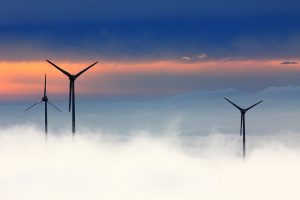 English available languages
English available languages
Renewables overtook coal as Germany‘s main source of energy for the first time last year, accounting for just over 40 percent of electricity production. The shift marks progress as Europe’s biggest economy aims for renewables to provide 65 percent of its energy by 2030 in a costly transition as it abandons nuclear power by 2022 and is devising plans for an orderly long-term exit from coal.
The research from the Fraunhofer organization of applied science showed that output of solar, wind, biomass and hydroelectric generation units rose 4.3 percent last year to produce 219 terawatt hours (TWh) of electricity. That was out of a total national power production of 542 TWh derived from both green and fossil fuels, of which coal burning accounted for 38 percent. Green energy’s share of Germany’s power production has risen from 38.2 percent in 2017 and just 19.1 percent in 2010.
Bruno Burger, author of the Fraunhofer study, said it was set to stay above 40 percent this year.
“We will not fall below the 40 percent in 2019 because more renewable installations are being built and weather patterns will not change that dramatically,” he said.
Green power skeptics say that output merely reflects favorable weather patterns and does not prove the sector’s contribution to secure energy supplies.
 Solar power increased by 16 percent to 45.7 TWh due to a prolonged hot summer, while installed capacity expanded by 3.2 gigawatts (GW) to 45.5 GW last year, according to the Fraunhofer data. The wind power industry produced 111 TWh from combined onshore and offshore capacity of just under 60 GW, constituting 20.4 percent of total German power output. Wind power was the biggest source of energy after domestically mined brown coal power which accounted for 24.1 percent. Coal plants run on imported hard coal contributed 75.7 TWh, or 13.9 percent of the total.
Solar power increased by 16 percent to 45.7 TWh due to a prolonged hot summer, while installed capacity expanded by 3.2 gigawatts (GW) to 45.5 GW last year, according to the Fraunhofer data. The wind power industry produced 111 TWh from combined onshore and offshore capacity of just under 60 GW, constituting 20.4 percent of total German power output. Wind power was the biggest source of energy after domestically mined brown coal power which accounted for 24.1 percent. Coal plants run on imported hard coal contributed 75.7 TWh, or 13.9 percent of the total.
Hydropower only accounted for 3.2 percent of power production at 17 TWh, as extreme summer heat dried out rivers and was accompanied by low rainfall. Biomass output contributed 8.3 percent. Gas-to-power plants accounted for 7.4 percent of the total; nuclear energy for 13.3 percent; with the remainder coming from oil and waste burning. Germany was a net exporter of 45.6 TWh of power in 2018, mostly to the Netherlands, while importing big volumes from France
 English available languages
English available languages
